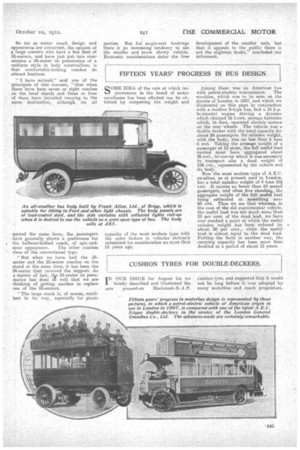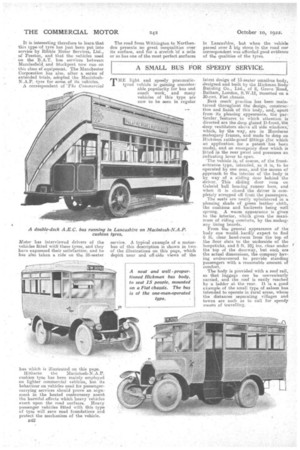PASSENGER TRAVEL NEWS.
Page 28

Page 29

Page 30

If you've noticed an error in this article please click here to report it so we can fix it.
The Latest Doings and Developments in the Bus and Coach World.
THE SCOPE OF MOTOR COACHING.
Taking Passengers off the Beaten Track. Effect of Cheap Rail Fares. Preferences in Coach Design.
DURING the past summer meter coach owners in many districts have experienced an ent rely new set of conditions. In the firse place, motor coaching has ceased to 'be'a noVelty ; it has become an institution. Consequently passengers who at bee time-were tempted to go for a ride out of sheer curiosity, must now be appealed to by other means.
The prevailing industrial conditions and the number of cheap railway excursions have also been factors that have exerted an influence that was not so pronounced last year, and, unfortunately, when one is analysing the motor coach industry, these cannot be dismissed as considerations not worthy of attention. If there he one other matter that has militated against the complete success of motor coaching this year, it has been the continued bad weather.
If motor coach owners as a body have one outstanding fault, it is their ure imaginativeness. When one pen-rises day after day, week after week, and month after month the announcements of owners who run their vehicles oh trips to certain popular resorts within 40 or 50 miles' radius, to which there is an excellent railway service—and excursion fares—one is left wondering whether those owners are making the best of their opportunities.
There is no such thing as static conditions in any industry. What rouses the enthusiasm of the public one day may leave them unmoved the next; and hence the manner of appealing to the public must be eonsidered quite as .much as the particular outing which it is intended to offer the passenger. The methods of 1920 might have been end
nently successful, these of 1921 might have been similarly so, but can the same be sadd of 1922?
Reference has been made to tours run to those resorts which the railway companies delight in flooding with day trippers. No one questions their right, but at the same time the fact is forced upon one that, even if this year coach owners can hold up their heads in competition with the railway companies in the matter of fares, the railway com• panies will ultimately be able to run excursion trains at fares which no coach owner will beable.twentertain. .
At the present time one of the Northern railway companies is running excursions several times a week from the important city A to the popular watering-place B-94 miles-away, the fare being 7s. The journey can be made by coach for 7s. 6d. return. One ventures to assert that. by adopting aggressive advertising methods, and by letting the publicknow that they would enjoy 94 miles of country in comfort, would make the journey almost as quickly and would arrive back home at a time more certain than the railway companies could guarantee with an excursion train, the coach owners engaged in running vehicles on this particular tour would make it a great access.
IS IT WORTH SIXPENCE MORE? is the point of appeal—then could follow a bright, snappy story of the run. Such an appeal would not fail to stir the public. There is a feeling developing amongst many coach owners that the places to which regular railway excurslang are run can no longer be regarded as suitable destinations for coaches on which single-seat bookings prevail, be cause the. public fed rather than know that they can get there cheaper by train.
Some coach owners have complained of " the lack of destinations " which have an attraction. for the public (one is speaking now of the owners in industrial districts), and others have devised what they call circular tours, which have beau carefully arranged so as to take passengers off the beaten track.
Coach owners who have been hard at work popularizing these tours (cannot a better title than "' circular tour" be devised?) report that they have taken very well; more so, in fact,than some of the service runs to places -better
known. .
Such runs may be 20, 30, 40 or even NO miles away; according to the cape, city of theepublic to pay. The organization of these 'tours is no more difficult than the ordinary 'day runs, and if coach owners can get together picnic parties, and can arrange for wp.rm liquid refreshment to be served at lunch and at tea-times, there is no reason why . the spectacular side of motor coaching should not again be in the ascendant.
What doe's it involve and what is the expense? All the requisites for this class of service are heating apparatus, a boiler and crockery, the cost Of the refreshments, etc., being a charge to be defrayed by the passengers themselves, Furthermore, On these excursions into the countryside no harm is done by an hour or two's stop at some quiet little beauty spot to enable passengers to stretch their legs and have a look round. Meanwhile, the driver could be making preparations for tea.
The competition of alternative forms of transport cannot altogether be said to be harmful. ft compels coach owners to think, and to think interi: sively, about the lau4iness side of motor coaching. It stimulates enterprise and alertness, as well as being the means for giving new ideas a chance.
So tar as motor coach design and appearance axe concerned, the opinion of a large concern who have a fine fleet of 33-seaters, and have just put into commission a 24-seater on pneumatics of a uniform style in body construction; is that comfortable-looking coaches do attract business.
" I have noticed," said one of the principals of this concern, 'that when there have been seven or eight coaches on the local stands and three or four of them have intended rt.:inning to the same destination, although we all
quoted the same fares, the passengers have generally shown a preference for the bulbous-bodied coach, of spic-and span appearance. The other coaches ' were of the conventional type.
"But when we have bad the 24seater and the 33-seater coaches on the stand at the same time, it has been the 24-seater that received the support. As a matter of fact, the 24-seater on pneumatics has done at well that we are thinking of getting another to replace one of the 33-seaters.
"The large coach 'is, of course,. excellent in its way, especially for picnic
parties. But for' single-seat bookings there is an incre sing tendency to use the smaller and nore showy vehicle. Economic considerations deter the free
development of the smaller unit, but that it appeals to the public there is not the slightest doubt," concluded our informant.
FIFTEEN YEARS' PROGRESS IN BUS DESIGN.
COME IDEA of the rate at which provement in the breed of motor omnibuses has been effected can be obtained by comparing the weight and
capacity of the most modern type. with the same factors in vehicles seriously submitted for consideration no More than 15 years ago. Among these Was an American bus
with petrol-electric transmission. The machine which was to be seen on the streets of London in 1907, and which we illustrated on this page in conjunction with a modern S-type bus, had a 16 h.p. hcrizontal engine driving a dynamo which charged 16 1-divt. storage batteries which, in turn, operated electric motors on the rear wheels. The vehicle was a double decker with the total capacity for about 24 passengers. Its unladen weight, with the body, was no less than 6 tons 6 nwt. Taking the aveuage weight of a passenger at 12 stone, the full useful load carried must have aggregated about 36 cwt., to-convey which it was necessary to transportalso a dead weight Of 126 cwt., represented by the vehicle and its body.
Now the most modern type of A.E.C. omnibus, As at present used in London, has a total unladen weight of 4 tons 11lIa -cwt. It carries no fewer than 54 seated passengers, and often five standing, the aggregate weight of the full useful load being estimated at something near 85 cwt. Thus we see that whereas, in the case of the old experimental vehicle, the useful load was not much more than 25 per cent, of the dead load, we have now reached a point at which the useful unladen weight has been reduced by • about 30 per cent. while the useful load is almost equal to the dead] load. Putting the facts in another way, the carrying capacity has been more than doubled in a period of about 15 years.
CUSHION TYRES FOR DOUBLE-DECKERS.
IN OUR ISSUE for August 1st we briefly described and illustrated the new pressed-on Macintosh-N.A.P.
cushion tyre, and suggested that it would not he long before it was adopted by many motorbus and coach proprietors.
It is interesting therefore to learn that this type,of tyre has just been put into service by Ribble Motor Services, Ltd., cif Preston, and that the vehicles used on the B.A.T. bus services between Macclesfield. and Stockport now run--on this class of equipment. The Manchester Corpovation has also, after a series of extended trials, adopted the MacintoshN.A.P. -tyre for some of its vehicles. A correspondent of 'Tice Camtnercia4
The road from Withington to Northenden presents no great inequalities over its surface, and for a stretch of a mile or so has one of the most perfect surfaces
in Lancashire, but when the vehicle passed over 3, big stone in the road our correspondent was afforded good evidence of the qualities of the tyres.
A SMALL BUS FOR SPEEDY SERVICE.
rr HE light and speedy pneumatic
tyrul vehiele isgaining considerable popularity for bus and coach work' and many vehicles of this type are now to be seen in regular latest design of I5-seater omnibus -body, designed and built, by the Hickman BodyBuilding Co., Ltd., of 8, Grove 'Road, Balnam, London, S.W,12, Mounted on a 30-cwt. Fiat chassis.
Best coach practice has been main
tined throughout the design, construction and finish of this body, and, apart from its pleasing appearanee, the particular features to which attention is directed are the deep glazed D-front,thé deep ventilators above all side windows; which, bythe way, are in Honduras -mahogany frames, and made to drbp on Hiekman rattle-proof fittings .(for which an application for .a patent' has been made), and an emergency door which is fitted in the rear panel and possesses an indicating lever to open.
'The vehicle is, of course, of the frontentrance type, intended, as it is, to be operated by one man, and-the means of approach to the interior of the body is by way of a sliding door behind the driver. This sliding door runs on Gabriel ball bearing runner bars, and when it is closed the driver is completely screened off from the passengers.
The seats are neatly upholstered in a pleasing shade of green leather cloth, the cushions and backrests being well sprung. A warm appearance is given to the interior, which gives the Maximum of riding comforts, by the mahogany lining boards.
From the general appearance of the body one wouldhardly expect to find 6 ft. clear head-room from the top of the floor slats to tire underside of the heopsticks, and 5 ft. 101ins. clear under the top of the doorway, but such are the actual dimensions, the company hay-. lug -endeavoured to provide standing passengers with a reasonable amount of comfort.
The body is Provided with a roof rail, so that luggage can be conveniently carried, and, the roof is easily reached by a ladder at the rear. It is a good example of the small type .:).1 saloon bus intended, to operate in rural areas, where the distances separating villages and towns are such as to call for speedy means of travelling.


































